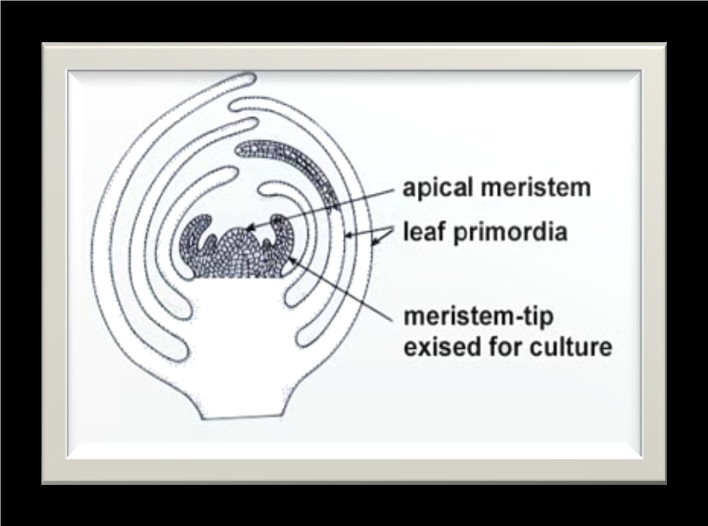Meristem culture — Production of diseases free plants
P. S. Devanand*, B. Sivakumar, K. Sivakumar, N. Raja, K. Hemaprabha, K. B. Sujatha, K. Nelson Navamani Raj, R. Vijayan, S. Utharasu, K. Kumar, R. Revathi
July 2nd 2025, 3:03:34 am | 5 min read

Introduction
Meristem cultures mainly provide a means of vegetative propagation, in vitro germplasm storage and virus eradication. They have therefore found extensive application - particularly for vegetatively propagated horticultural crops - for over 40 years. Meristem culture for micropropagation and in vitro germplasm storage has been described in forage grasses, although in this context it is undoubtedly not as commercially compelling as in normally vegetatively propagated crops.
A major advantage of working with such a small explant is the potential that this holds for excluding pathogenic organisms that may have been present in the donor plants from the in vitro culture. A second advantage 1s the genetic stability inherent m the technique, since plantlet production 1s from an already differentiated apical meristem and propagation from adventitious meristems can be avoided. Shoot development directly from the meristem avoids callus tissue formation and adventitious organogenesis, ensuring that genetic instability and somaclonal variation are minimized. If there is no requirement for virus elimination, then the less demanding, related technique of shoot-tip culture may be more expedient for plant propagation.
Meristem
A meristem is the tissue in all plants consisting of undifferentiated cells (meristematic cells), found in zones of the plant where growth can take place. Groups of cells that are the source of new cells form tissue called meristem. Meristem cells aren't specialized, but when they divide, some of the new cells specialize into tissues. Areas of growth that lengthen the tips of roots and stems are called apical meristems. Lateral meristems, found all along woody roots and stems, increase the thickness of these plant parts.
Meristem Culture Technique
The culture of meristem involves three stages:
1- Culture establishment,
2- Multiplication of the propagules and
3- Root regeneration
Explant
The explant of meristem culture may either be the apical dome(apical meristem) or more frequently, the apical dome plus a few subjacent leaf primordia (the sub apical meristematic region).The apical meristem is located at the extreme tip of a shoot and measure 0.1 mm in diameter and 0.25 to 0.30 in length.

Culture Establishment
Culture can be established from meristem, shoot tips or axillary buds. For shoot regeneration from meristem, young development stage of meristem has been found to be optimum. Therefore, it is desirable to excise terminal explants for culture. Axillary buds are preferred since there would be only one terminal bud per shoot. Further, the explants should be larger enough for getting successful results. So larger explants like shoot tips and buds have to be chosen instead of minute meristems.
After explant excision, they are inoculated into culture medium. Generally there is no necessity for the addition of exogenous hormones in the medium since sufficient quantity of endogenous hormone is present in the shoot apices. However, there are cases in which exogenous auxin is applied to get better results. Among the auxins, NAA is the auxin routinely used for meristem tip and bud cultures.
Applications of meristem culture
In vitro micropropagation
The micropropagation technique through meristem or shoot tip culture favours production of thousand and thousands of plants from a single explant within a short period. Moreover, once a stock of multiple shoot culture is established, it can continuously serve as the source material instead of having to restart from fresh explant cultures periodically.
Production of pathogen free plants
The most important application of micropropagation technique via meristem culture is the production of pathogen free plants, especially viruses as they are absent in apical meristem. Plants are often infected with more than one type of virus, including some even not known.
Generally, viruses infect plant species systemically making the plants to die. In some cases of meristem tip culture the heat therapy has necessarily to be followed to eliminate the viruses. For example, in the carnation, heat therapy of plants at 38°C for two months followed by meristem culture eradicated all the viruses.
The proposed reasons for meristem’s virus freeness:
1- The absence of vascular connections
2- The high metabolic activity of the meristematic cells which prevent virus multiplication
3- The high activity of the affective virus abolishing group in meristems
4- The high auxin levels in apical meristems inhibits virus multiplication